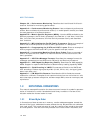
Vol. 3 1-5
ABOUT THIS MANUAL
Chapter 16 — Debugging, Branch Profiles and Time-Stamp Counter.
Describes the debugging registers and other debug mechanism provided in Intel 64
or IA-32 processors. This chapter also describes the time-stamp counter.
Chapter 17 — 8086 Emulation. Describes the real-address and virtual-8086
modes of the IA-32 architecture.
Chapter 18 — Mixing 16-Bit and 32-Bit Code. Describes how to mix 16-bit and
32-bit code modules within the same program or task.
Chapter 19 — IA-32 Architecture Compatibility. Describes architectural
compatibility among IA-32 processors.
Chapter 20 — Introduction to Virtual-Machine Extensions. Describes the basic
elements of virtual machine architecture and the virtual-machine extensions for
Intel
64 and IA-32 Architectures.
Chapter 21 — Virtual-Machine Control Structures. Describes components that
manage VMX operation. These include the working-VMCS pointer and the control-
ling-VMCS pointer.
Chapter 22— VMX Non-Root Operation. Describes the operation of a VMX non-
root operation. Processor operation in VMX non-root mode can be restricted
programmatically such that certain operations, events or conditions can cause the
processor to transfer control from the guest (running in VMX non-root mode) to the
monitor software (running in VMX root mode).
Chapter 23 — VM Entries. Describes VM entries. VM entry transitions the processor
from the VMM running in VMX root-mode to a VM running in VMX non-root mode.
VM-Entry is performed by the execution of VMLAUNCH or VMRESUME instructions.
Chapter 24 — VM Exits. Describes VM exits. Certain events, operations or situa-
tions while the processor is in VMX non-root operation may cause VM-exit transitions.
In addition, VM exits can also occur on failed VM entries.
Chapter 25 — VMX Support for Address Translation. Describes virtual-machine
extensions that support address translation and the virtualization of physical
memory.
Chapter 26 — System Management Mode. Describes Intel 64 and IA-32 architec-
tures’ system management mode (SMM) facilities.
Chapter 27 — Virtual-Machine Monitoring Programming Considerations.
Describes programming considerations for VMMs. VMMs manage virtual machines
(VMs).
Chapter 28 — Virtualization of System Resources. Describes the virtualization
of the system resources. These include: debugging facilities, address translation,
physical memory, and microcode update facilities.
Chapter 29 — Handling Boundary Conditions in a Virtual Machine Monitor.
Describes what a VMM must consider when handling exceptions, interrupts, error
conditions, and transitions between activity states.


















